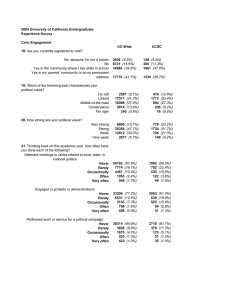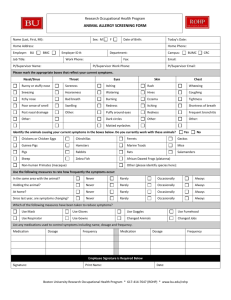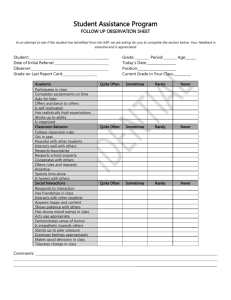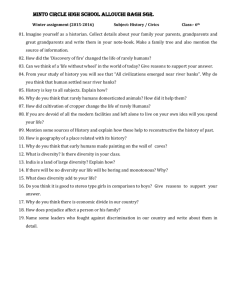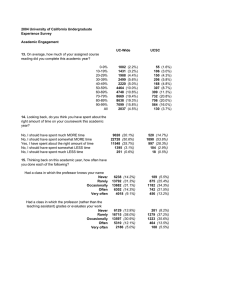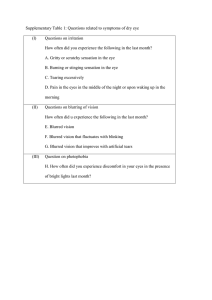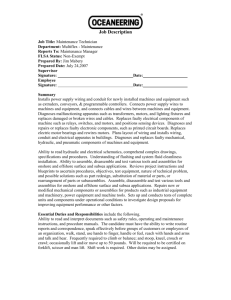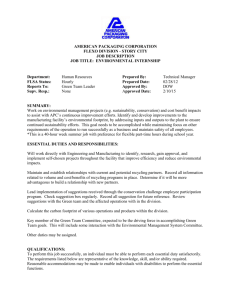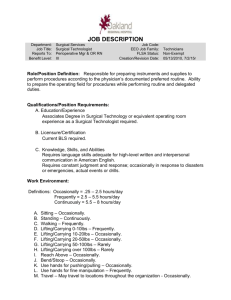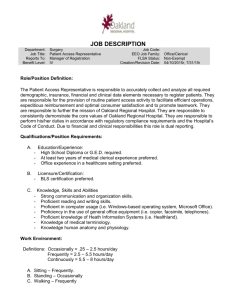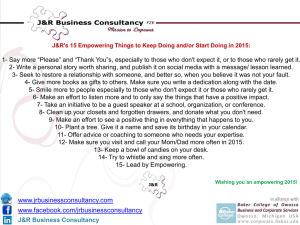Arts and Humanities - evaluation of professional dispositions
advertisement
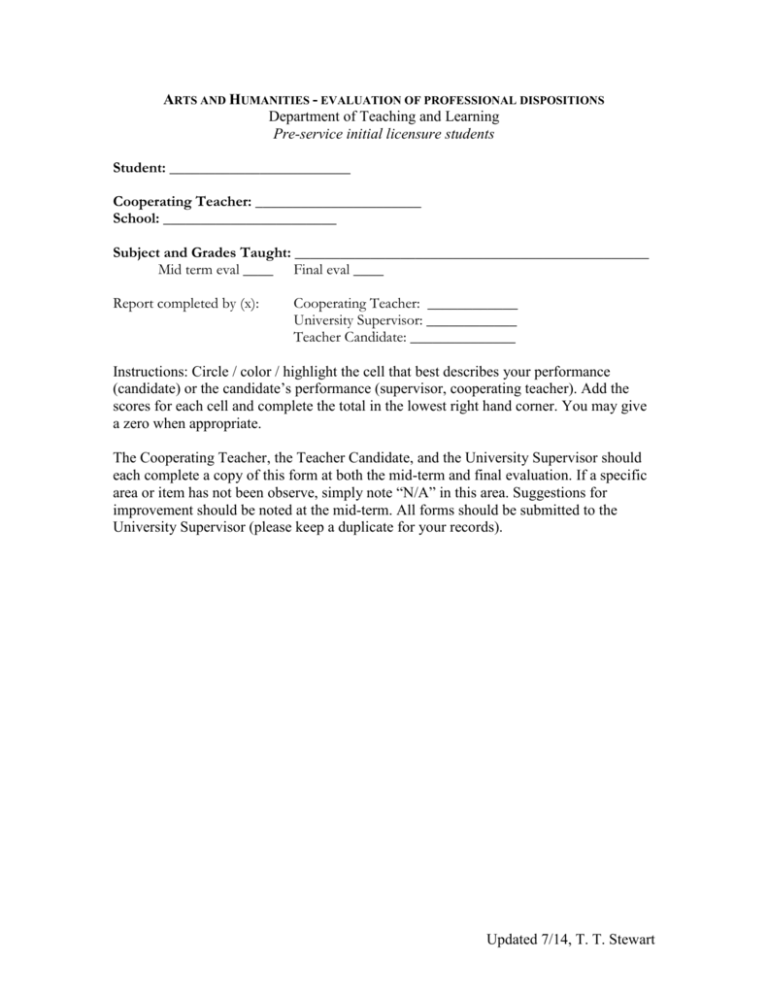
ARTS AND HUMANITIES - EVALUATION OF PROFESSIONAL DISPOSITIONS Department of Teaching and Learning Pre-service initial licensure students Student: ________________________ Cooperating Teacher: ______________________ School: _______________________ Subject and Grades Taught: _______________________________________________ Mid term eval ____ Final eval ____ Report completed by (x): Cooperating Teacher: ____________ University Supervisor: ____________ Teacher Candidate: ______________ Instructions: Circle / color / highlight the cell that best describes your performance (candidate) or the candidate’s performance (supervisor, cooperating teacher). Add the scores for each cell and complete the total in the lowest right hand corner. You may give a zero when appropriate. The Cooperating Teacher, the Teacher Candidate, and the University Supervisor should each complete a copy of this form at both the mid-term and final evaluation. If a specific area or item has not been observe, simply note “N/A” in this area. Suggestions for improvement should be noted at the mid-term. All forms should be submitted to the University Supervisor (please keep a duplicate for your records). Updated 7/14, T. T. Stewart DISPOSITIONS AND ATTITUDES Presenting oneself professionally – in appearance, speech and behavior. Being punctual for class sessions and in the field. Checking and responding to email every day. Presenting work that is consistently on time, well prepared and accurate to the best of your ability. Participating with maximum intellectual effort in discussions that are both thoughtful and thought-provoking reflections of English Education experiences. Maintaining an air of respect, honesty and rapport with peers, professors, K12 teachers and students, and community members. Reflecting on the quality of one’s own teaching and always being open to improvement Being willing to self-assess, and act on evaluations of the supervisor and the cooperating teacher Being prepared to illustrate fairness in behaviors in the field and adopting the ideal that all children can learn. Always Consistently Infrequently Action to be taken Notes: Updated 7/14, T. T. Stewart FAIRNESS 1 Basic- Occasionally Observed 2 Proficient- Frequently Observed 3 Distinguished-Consistently Observed Score Instruction Rarely/Occasionally engages in instructional sequences that encourage “openmindedness, whole heartedness and responsibility” * Rarely/Occasionally identifies instructional process that are unfair Rarely/Occasionally provides individualized instruction Rarely/Occasionally recognizes and acts on the need to differentiate /accommodate for differences Generally engages in instructional sequences that encourage “openmindedness, whole heartedness and responsibility” * Identifies some instructional process that are unfair Generally provides individualized instruction Generally recognizes and acts on the need to differentiate /accommodate for differences Consistently engages in instructional sequences that encourage “openmindedness, whole heartedness and responsibility” * Identifies, with clarity, instructional process that are unfair Always provides individualized instruction Recognizes and acts on the need to differentiate /accommodate for differences Updated 7/14, T. T. Stewart Equal treatment Rarely/Occasionally treats children fairly in terms of class rules Rarely/Occasionally seen treating children equitably Is seen to profile students Is seen listening to one side of a story in conflict situation only Is rarely/occasionally observed attempting to listen to every child Rarely/Occasionally uses consistent discipline for all children Is rarely/occasionally observed following through with consequences for all children Is not consistently seen responding to others’ unfair behavior Generally treats children the same or fairly in terms of class rules Generally seen treating children equitably Mostly avoids profiling students Is seen trying to listen to both sides of a story in most conflict situations Is observed generally attempting to listen to every child Generally uses consistent discipline for all children Is generally observed to follow through with consequences for all children Is generally consistently seen responding to others’ unfair behavior Is generally seen treating children the same way with the same rules Always treats children the same or fairly in terms of class rules Consistently seen treating children equitably Never profiles students Is seen listening to both sides of a story in conflict situations Is observed attempting to listen to every child Discipline Uses consistent discipline for all children Is observed to always follow through with consequences for all children Is consistently seen responding to others’ unfair behavior Is seen treating children the same way with the same rules Updated 7/14, T. T. Stewart Participation Is rarely/occasionally observed calling on all students Rarely/Occasionally gives everyone a turn Rarely/Occasionally creates equal opportunities for all student to participate Rarely/Occasionally models fairness, openmindedness, wholeheartedness, responsibility in their classrooms Is generally observed calling on all students Inconsistently gives everyone a turn Generally creates equal opportunities for all student to participate Generally models fairness, open-mindedness, wholeheartedness, responsibility in their classrooms Is observed always calling on all students Consistently gives everyone a turn Always creates equal opportunities for all student to participate Modeling Always models fairness, open-mindedness, wholeheartedness, responsibility in their classrooms TOTAL SCORE 0-4 Unacceptable 5 –8 Basic; 9 – 13 Proficient; 14-15 Distinguished Adapted from Parkes, updated Jan 2013. Updated 7/14, T. T. Stewart *Taxonomy of Instructional Dispositions The following table is designed to help in evaluating the abilities of the intern to develop instruction that is designed to bring about specific dispositions in the classroom and foster their students’ dispositional development. It is not expected that interns will do all this within their lessons, however, this taxonomy provides criteria that may well be stressed in lessons designed to educate future citizens. This list comes from: Misco, T., and Shiveley, J. (2010). Seeing the forest through the trees: Some renewed thinking on dispositions specific to social studies education. The Social Studies, 101, 121-126. Open-Mindedness Tolerance Skepticism Embracing ambiguity Dissent Rationality Embracing Diversity Curiosity Sympathy/Empathy Experimentation Wholeheartedness Self-discipline Individual responsibility Patience Persistence Compromise Love of perfection Loyalty Pursuit Frankness Fortitude Responsibility Commitment to justice Compassion Generosity Work for Common Good Honesty Respect for the rights of others Respect for the property of others Benevolence Dignity of others Opportunity Belief in democratic principles Adherence to the rule of law Support of fundamental human rights Updated 7/14, T. T. Stewart
